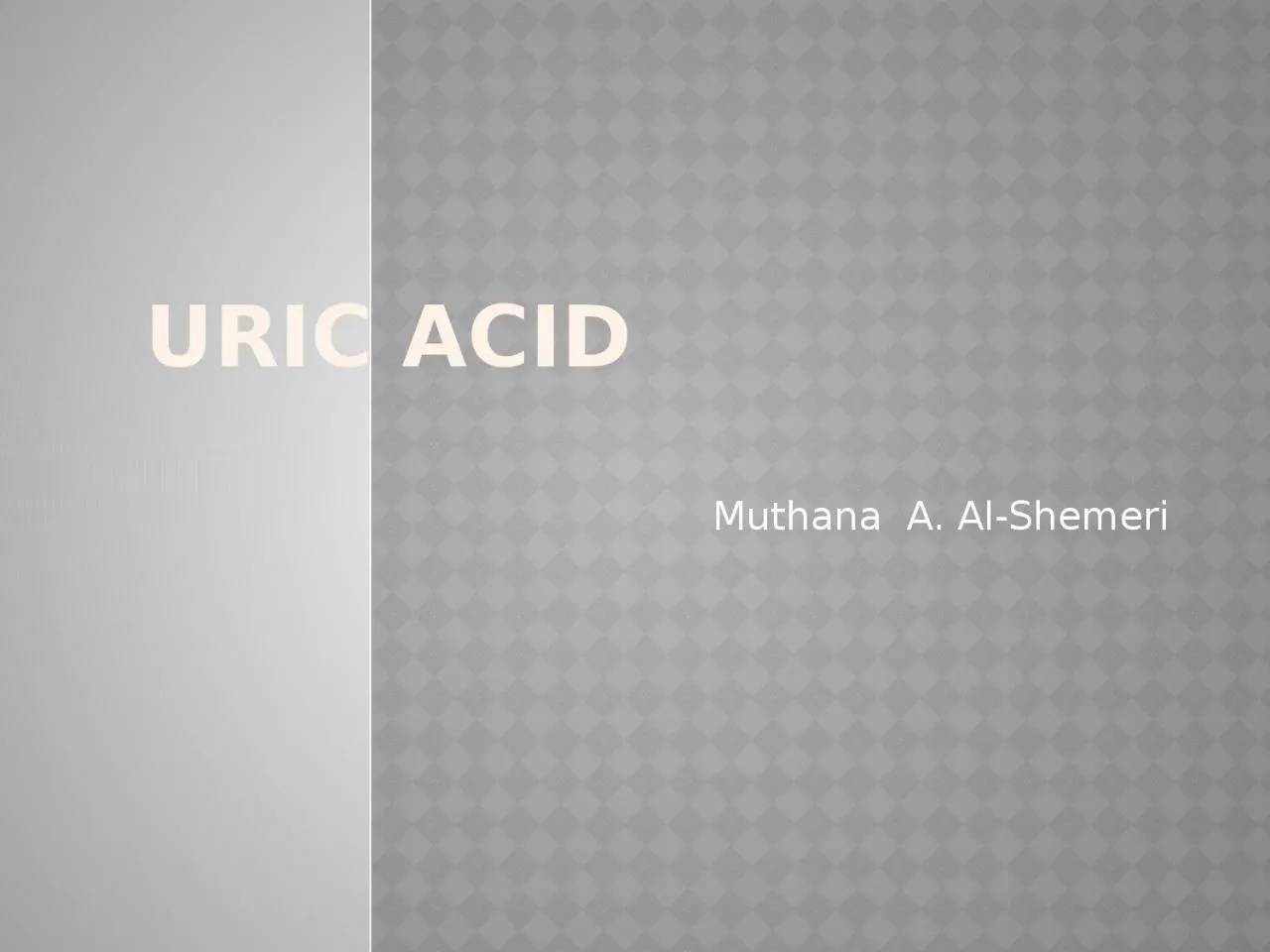

Shemeri Introduction Uric acid is the product of catabolism of the purine nucleic acids Although it is filtered by the glomerulus and secreted by the distal tubules into the urine most uric acid is reabsorbed in the proximal tubules and reused ID: 999216
Download Presentation The PPT/PDF document " URIC ACID Muthana A. Al-" is the property of its rightful owner. Permission is granted to download and print the materials on this web site for personal, non-commercial use only, and to display it on your personal computer provided you do not modify the materials and that you retain all copyright notices contained in the materials. By downloading content from our website, you accept the terms of this agreement.
1. URIC ACIDMuthana A. Al-Shemeri
2. IntroductionUric acid is the product of catabolism of the purine nucleic acids. Although it is filtered by the glomerulus and secreted by the distal tubules into the urine, most uric acid is reabsorbed in the proximal tubules and reused. Uric acid is relatively insoluble in plasma and, at high concentrations, can be deposited in the joints and tissue, causing painful inflammation.
3. StructurePrinciple Uric acid oxidized by uricase to allautoine and hydrogen peroxide, according to the following equation:
4. PhysiologyPurines, such as adenosine and guanine from the breakdown of ingested nucleic acids or from tissue destruction, are converted into uric acid, primarily in the liver. Uric acid is transported in the plasma from the liver to the kidney, where it is filtered by the glomerulus. Reabsorption of 98% to 100% of the uric acid from the glomerular filtrate occurs in the proximal tubules. Small amounts of uric acid are secreted by the distal tubules into the urine.
5. Renal excretion accounts for about 70% of uric acid elimination; the remainder passes into the gastrointestinal tract and is degraded by bacterial enzymes. Nearly all of the uric acid in plasma is present as monosodium urate. At the pH of plasma (pH;7), urate is relatively insoluble; at concentrations greater than 6.8 mg/dL, the plasma is saturated. As a result, urate crystals may form and precipitate in the tissues. In acidic urine (pH <5.75), uric acid is the predominant species and uric acid crystals may form.
6. Clinical ApplicationUric acid is measured to assess: 1-Inherited disorders of purine metabolism. 2-To confirm diagnosis and monitor treatment of gout. 3-To assist in the diagnosis of renal calculi. 4-To prevent uric acid nephropathy during chemotherapeutic treatment. 5-To detect kidney dysfunction.
7. Specimen Requirements and Interfering SubstancesUric acid may be measured in heparinized plasma, serum, or urine. Serum should be removed from cells as quickly as possible to prevent dilution by intracellular contents. Diet may affect uric acid concentration overall, but a recent meal has no significant effect and a fasting specimen is unnecessary. Gross lipemia should be avoided. Drugs such as salicylates and thiazides have been shown to increase values for uric acid.
8. Uric acid is stable in plasma or serum after red blood cells have been removed. Serum samples may be stored refrigerated for 3 to 5 days. Ethylenediaminetetraacetic acid (EDTA) or fluoride additives should not be used for specimens that will be tested by a uricase method. Urine specimens must be alkaline (pH 8).
9. Reference Intervals(0.21-0.43 mmol/L)3.5-7.2 mg/dLPlasma or serumAdultMale(0.16-0.36 mmol/L)2.6-6.8 mg/dLPlasma or serumAdultFemale(0.12-0.33 mmol/L)2.0-5.5 mg/dLPlasma or serumChild(1.5-4.4 mmol/day)250-750 mg/dayUrine, 24-hAdultResults expressed in conventional units of milligrams per deciliter can be converted to international units using the molecular mass of uric acid (168 g/mol).
10. SummaryInherited disorders of purine metabolism are associated with significant increases in physiological uric acid concentrations. Elevated plasma uric acid concentration is found in gout, increased catabolism of nucleic acids, and renal disease. Gout is a disease found primarily in men and usually is first diagnosed between 30 and 50 years of age. Affected individuals have pain and inflammation of the joints caused by precipitation of sodium urates.
11. hyperuricemiais a result of overproduction of uric acid, although hyperuricemia may be happen regarding to a purine-rich diet, drugs, and alcohol. Plasma uric acid concentration in affected individuals is usually greater than 6.0 mg/dL. Patients with gout are very susceptible to the development of renal calculi, although not all persons with high serum urate concentrations develop this complication. In women, urate concentration rises after menopause.
12. Another common cause of elevated plasma uric acid concentration is increased metabolism of cell nuclei, as occurs in patients on chemotherapy for such proliferative diseases as leukemia, lymphoma, multiple myeloma, and polycythemia. Monitoring uric acid concentration in these patients is important to avoid nephrotoxicity. Allopurinol, which inhibits xanthine oxidase, an enzyme in the uric acid synthesis pathway, is used as treatment.
13. Hypouricemiais less common than hyperuricemia and is usually secondary to severe liver disease or defective tubular reabsorption, as in Fanconi syndrome. Hypouricemia can be caused by chemotherapy and as a result of overtreatment with allopurinol.
14. شكرآ